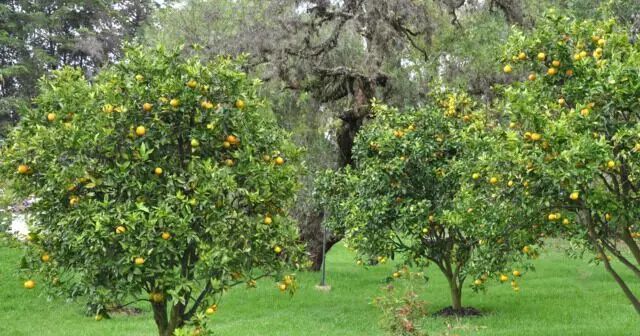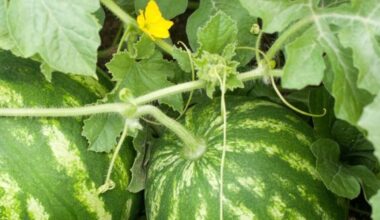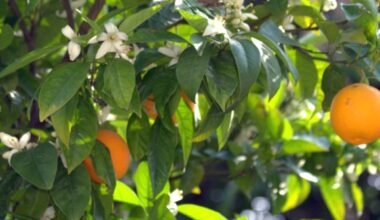Maintaining a lemon tree in the ground is easy, it just requires following some basic rules. To harvest beautiful lemons, provide your lemon tree with special citrus fertilizer regularly throughout the year. Water them in the summer, and bring in the lemon trees in the winter. The good maintenance of the lemon tree also brings it a good health.
But this maintenance varies according to the seasons: in spring, fertilization and pruning are the key words, while in summer you should mainly take care of watering; the cold season, on the other hand, will require the best protection for this great cold weather tree.
Contents
Maintenance of outdoor lemon trees in spring
As soon as the weather is nice, mid-May and the frosts are over, you can take the potted lemon tree out of its winter shelter. However, avoid placing it directly in the sun; it will have to get used to the sun’s rays little by little by first placing it in semi-shade.
It is also possible, depending on the temperature and to avoid an abrupt change in growing conditions, to take the lemon tree out during the day and bring it inside for the night before leaving it outside for the whole summer. Indeed, it is not rare that the nights are still much too cold to expose the cold lemon tree.
Another important point: shelter the shrub from the wind. The wind dries out the leaves and the soil, and the temperature variations are more accentuated.
Watering in spring
The watering of the lemon tree in spring must be regular, copious, but without excess. It is advisable to raise the pot in relation to the saucer (with gravel, clay balls or an upturned saucer), or even to remove the saucer, as too much water at the roots is dangerous for the health of the shrub. This watering can be done with rain water or with water from the network if you take the precaution of leaving it for 24 hours before watering.
Fertilization in spring
Among the maintenance tasks of the 4 seasons lemon tree and other varieties, the contribution of fertilizer is an important point for a good fructification, and this more particularly if the shrub is cultivated in pot. The needs are not the same depending on whether the lemon tree is young or not. In the first case, its most important needs are in nitrogen, later it will require more potash.
Make a first contribution of special citrus fertilizer once you have harvested, in early spring. For lemon trees in pots, fertilization will be done monthly starting in spring, either with nitrogen fertilizer for citrus or with complete fertilizer granules.
The liquid fertilizer mixes with the water while the granules slowly release their nutrients. Caution: never give liquid fertilizer to a thirsty shrub, as this could burn its roots.
Pruning in spring
Prune the lemon tree by making several small pinches during the vegetative season, spring and summer (between March and July ideally). The lemon tree is indeed a vigorous shrub, whose young shoots develop very quickly. However, you can only cut them back when they are already well-developed, as the leaves become hard and darker green.
You will prune the shoots that unbalance the silhouette of your lemon tree, you can also remove the branches that are misdirected, that go towards the inside of the branch, that are in excess. The young branches are cut back above the 4th or 5th leaf. The objective is to obtain a shrub with a rounded shape. It is on the wood of the year that the lemon tree bears fruit, so you can also remove the branches that have already borne fruit but be careful not to prune your lemon tree too much.
Repotting in spring
Repotting a lemon tree is an action that should be carried out ideally every 3 years to aerate the soil and allow the plant to feed itself properly. Avoid choosing too large volumes and increase the size of the container very gradually, as the lemon tree is known for its tendency to first colonize the surface of the soil before starting to flower.
When the lemon tree is too big to be changed, you will have to be satisfied with an annual resurfacing: remove the upper surface of the substratum taking care not to damage the rootlets and replace the substratum by organic matter, compost and manure for example.
Unless you have planned ahead by providing a wooden tray, whose removable walls allow the replacement of most of the substrate. Simply scrape off the potting soil from all sides, replace the walls and replace with good potting soil enriched with compost and manure.
Maintenance of the outdoor lemon tree in summer
Fertilization in summer
Apply special citrus fertilizer, rich in nitrogen, to the lemon tree in the open ground at the very beginning of summer. The monthly fertilization of the lemon tree in pot continues all summer long, and you can replace the nitrogen fertilizer by a PK fertilizer (richer in phosphorus and potassium and less in nitrogen) to favor the fruiting.
Watering in summer
How to water the lemon tree in summer outdoors? In the open ground, when the weather is dry, you should water the tree 3 times a week, several dozen liters each time (up to a hundred liters for the largest plants). A young lemon tree in the ground will be watered more abundantly because its roots are not yet deep enough to seek the available water in depth.
A lemon tree in a pot will be watered every 2 days, but make sure that there is never stagnant water in the saucer. In fact, it is better to remove it. A daily shower is also welcome in the hottest periods.
Lemon trees and their citrus cousins have a very visible method of showing they are thirsty: their leaves curl up and hang down. Without supplementation, they eventually turn yellow and fall off.
Outdoor lemon tree care in fall
Reduce watering but never stop. Continue to fertilize by bringing composted organic matter to the foot of the lemon tree in the ground and dehydrated for the lemon tree in a pot.
Wintering in autumn
From October to November, bring in lemon trees in containers in an airy, bright room, kept at a temperature between 5 and 10°C ideally.
How to maintain a lemon tree indoors? The lemon tree is not an indoor plant, it will not support the temperature conditions, especially in winter.
You will opt instead for a calamondin, a citrus fruit which is a hybrid between the kumquat and the mandarin tree and which is the only citrus fruit that can be really cultivated indoors.
Maintenance of the outdoor lemon tree in winter
Watering in winter
Even in winter, the lemon tree should not lack water. However, do not water too much, the soil must remain cool, so that the fruits can grow. A contribution every 2 weeks is generally advised.
Wintering
How to store a lemon tree in winter? A lemon tree in the ground will be protected if necessary by a wintering veil, as well as a lemon tree in a pot if it is too big to be put under cover. The latter will help gain a few degrees and protect the shrub from the wind, which amplifies the effects of the cold.
To install a wintering veil, plant stakes a little higher than the lemon tree all around it to place the veil. This way, it will not touch the leaves and the risks due to condensation will be avoided. You can also install a fence to support the wintering veil. However, do not forget to raise the wintering veil if the temperature becomes milder, even if only for a few hours, to ventilate the shrub.
The most fragile lemon trees are the youngest ones, but the risk is a sudden freeze when the plant is not yet completely dormant (a little sap continues to circulate), or a late freeze on the young shoots. The longer the frost period, the higher the risks.
A lemon tree that has been frozen is easily recognizable: its foliage changes color, dries out and falls off, its fruit is deformed and rots. What you need to do then is to cut it back by half, keep it (or place it if it was not the case) out of frost. When vegetation starts to grow again, around March or April, you may see new shoots appear.
What temperature for a lemon tree?
This shrub is a frileux, you will cultivate it in ground only in the zone of the orange tree, that is to say in the southeast of France, on the Mediterranean coast, as well as on the Basque coast. Indeed, it does not support the temperatures lower than – 5°, and still during very short periods.
However, it needs cold during the winter, a temperature higher than 10° makes it lose its leaves as well as its flowers. Make sure that your lemon tree in a pot, brought in for the winter, is well protected from the wind and in a frost-free and unheated room. However, make sure you have a winter cover for the coldest periods.
Good to know
Lemon trees do not all have the same hardiness depending on the variety. You should choose the ‘Meyer’ variety, the most rustic when not grafted, which can resist up to -9°. La Valette’ or ‘Variegata’ will not tolerate frost.
Harvesting lemons
Harvest the ripe lemons: they are yellow and easily detachable. They can however wait several weeks on the shrub. The harvest of a 4 seasons lemon tree (most of the lemon trees are of this type) occurs mostly between October and November, then between March and April. Do not hesitate to pick the lemons when they are ripe, not doing so slows down the development of the following ones.









